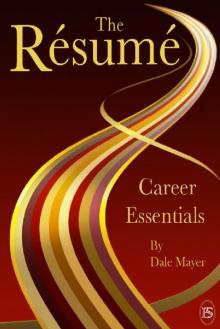- Home
- Dale Mayer
Career Essentials_The Interview Page 4
Career Essentials_The Interview Read online
Page 4
Contact information
First and foremost, your résumé is about you and what you have to offer a company so your name goes at the top of the page. Use your full name as it would appear on any official documentation that the recruiters may ask to see. Don’t use shortened versions of your name or nicknames.
If you are in the process of changing your name for some reason, place the older name in parentheses behind your new name.
Another possibility to consider is the number of people who go by their middle name. In this case, write your first name, then your middle name, followed by your surname so that there is no confusion. What you are trying to avoid is having anyone receive your application and wonder who owns the supporting documents. If you are called by a long-time nickname, put it in parentheses behind your first name and before your surname. For example: Meredith (Merry) Mitchell. In this case your legal name is Meredith and your nickname is Merry.
Below your name, write down your full address and phone number. If you are already employed and can’t have the potential employer calling your office, don’t put that number down. Do you want to take that call at work? Consider that the number may not be called for several months.
On the other hand, you need to make it easy for the prospective employer to contact you. If they try several times and can’t, why would they continue? For every job posted there are thousands of applicants. Many are just as educated and skilled as you are, so don’t assume the employer will continue to try. Cell phone numbers are a good way to go, providing you can answer it while on your current job. Be sure to have your voice mail set up just in case you miss the call. Many people avoid this step as voicemail costs when you are on a prepaid system. Set up voicemail before including your cell phone number as a contact option.
After the place you live, and the phone number you will answer, comes the email address you will use. Many people have more than one email address. Sometimes this is helpful, but other times it can be a detriment. When you start job hunting, determine which email is going to be your main contact email. Again, you aren’t likely to want that to be the email you use at your current job unless the company already knows that you are job hunting. Also do you want the new employer to see that you are doing this from your current job? He’s going to consider that if you are job hunting on the old company’s time, will you also job hunt on his time?
Be sure to have a business-like email address, name and address on the résumé. Many people think their emails are cute and suit them. That’s nice for personal relationships, but not professional ones. Make sure your email address suits the business-like tone of your résumé and not something that might have the new employer questioning who you are. Don’t use a cute, funny, or rude email address on your résumé. An email address that you might think isn’t going to be offensive may end up being just that. Don’t take the chance. The standard is to have your first name or initial followed by the last name. If your current email address is something different than a standard looking email, get a new one.
Another mistake that people often make is putting down a web address for a personal website. Only do this if the website is a business or professional site. It’s common for students to put down a website that to them, doesn’t contain any inappropriate material, but to a prospective employer could send up red flags.
You need to remember that an employer, in today’s overwhelming economic times, receives hundreds to thousands of applications for every job posted. They are looking for reasons to discard each and every résumé. Don’t make it easy for yours to be one of those.
However, if you are tech savvy enough to have documents uploaded in a professional format that are error-free and presented in a clear and accessible fashion, then go ahead and include your web address. Be sure to have this material on a separate page where it’s not open to the public in light of identity theft issues so common today. Better yet, place the material in folders that are behind a password. Consider including a web address if you have the following uploaded:
• Certifications
• Reference letters
• Academic papers
• Abstracts of published papers
• Lists of professional papers
• Presentations you have created and have the right to share
• An online résumé
• A portfolio containing representation of your creative ability like artwork, writing samples, websites, and photos. Make sure everything in this portfolio is relevant to the job. Keep it simple and brief. Employers are short on time and if photos won’t load, they will leave.
• Any other documentation pertinent to this job
Now that you know WHAT goes into this first block of information, how do you lay it out? There are several options.
You can center all the material on the page like this:
First name, Last name
Street Address
City, State, Zip
Phone Number
Email
Website
Alternatively, you can put the same information on the left or the right side of the page. If you need to put down two addresses, which is possible if you are a graduating student finishing up exams and moving back home again, set it up so one is on left and the other on the right.
If you are competent with a word processing program, you can also put the contact information in the footer of the page.
If you do, it will look something like this:
Name, Address, Phone Number, Email, Website
If you do choose to put this information in the footer at the bottom of the page, make sure your full name is still at the top of your résumé. The name is the only information that is duplicated.
Career goal or objective
There is a trend in today’s market to do away with the career goal or objective section. Some professionals feel including this section could reflect on your age as it’s an old fashioned trait. That isn’t necessarily true and for every recruiter who won’t want to see a career goal listed, there will be one that looks for it. This heading can also be changed to many other options, so pick what suits you. These are a few other suggestions:
Career – Proposal, Purpose, Qualifications, Vocation, Strengths, Talents, Expertise, Focus
There are several reasons not to put down a career statement. What if your statement isn’t in line with how recruiters view the job they are filling? Too often the career objectives don’t actually say much. In fact, so many are too general to say anything effectively or are too badly written to promote the applicant. In this case, they may be better left off the résumé.
If you are concerned about your career objective while applying for several jobs, you have the option of creating more than one résumé, each with its own variation of the career objective and even one without. If you are going to a job fair and won’t be able to individualize the career objective for each position then use a copy without an objective for just such an occasion.
So why would you want to have a career objective? And how should they be written? The purpose of a career goal is to let the recruiter know what type of position you want.
How to write it:
• Be clear
• Be concise
• Make the sentence active
• Make it specific
• Contains keywords for that job and your skills
• Highlight the employer’s needs rather than your own
Although these are the guidelines to follow, it’s important to remember that you aren’t trying to tell a story. You want a specific job and you have the skills to get the job.
Should your résumé be part of a scholarship or graduate school package, then you would state that in your career goal.
You need to avoid overused and clichéd phrases so commonly seen on résumés. Statements like the following are too general to be of value:
To obtain a meaningful and challenging position that enables me to learn the ac
counting field and allows for advancement.
Or
To obtain a position where I can use my skills and abilities to help the company and further my own education.
As you can see, they really don’t say anything. The recruiter can’t understand what you want or what you can do for them.
Now let’s take a look at a couple examples that do work.
Career objective: senior technical writer position using InDesign and XML/SGML experience
Or
Career Goal: game developer/artist team position using Flash CS3/CS4 and 3D Studio Max
View it this way; a career goal or objective should express what you want to achieve through the job application process and what skills and assets you offer the company.
When you write it this way, you are actually taking the career goals up another level to what some professionals are calling a positioning statement. It’s the same thing.
Years ago, career goals focused on the applicant. Instead, identify what you want and what you have to offer. Tailor your statement based on the company’s needs and what you have to offer and you’ll be fine.
Professional summary
This section is often called by many other names including Profile, Professional Profile, Summary, Summary of Qualifications, Highlights, Skills Summary, Key Features, and even Accomplishments. It goes either right under the Career Goals or at the top under your name. Which heading you choose isn’t the issue. Pick the heading you like and get to writing up this building block.
This section is considered your hook. This will draw in the reader by displaying your best assets in a way to show your value to the employer.
What goes in here? A lot of different elements might, depending on your skills and experience. Let’s take a closer look.
This section needs to include the important elements of who you are. It should include as many of the following elements as applicable to this job. Don’t make this a shopping list. The job ad is important here. You put down only what’s applicable to the job requirements. Remember everything needs to be put in terms of what benefits you offer the employer.
• Start by stating who you are and your position level or title.
• Follow that with your experience in the field in terms of years.
• Next, move into your areas of experience or specialization.
• List the highlights of your accomplishments.
• Any skills or additional experience that adds value and may be listed as an asset in the job ad.
• List advanced degrees, separate certifications, and additional licenses if you have any.
• If you have other skills, such as a second or third language, computer, business, or technical skills, then be sure to list them if they applicable to the type of position.
• List any awards received.
• List any affiliations and business associations – only if pertinent.
As always, when writing business communication material, do use the typical language of your industry. Do use the keywords that would make the employer sit up and take notice. Be specific and brief. This section is a summary. Don’t write a story or talk about your career aspirations and never state up front what your salary expectations are. Do use facts and figures to show your accomplishments, but only put down those that you can actually back up.
There are many different variations for this section because everyone has different experiences and skills to offer. Take your best points, and state them in a way that the employer can understand how they can benefit from hiring you. For example:
Sales manager with 15 years retail sales in office equipment that increased floor sales by 25 % over previous year. Won sales manager of the year for last two years.
In this case, the title, experience, industry, awards, and accomplishments have been stated. Clean and simple. There may be more that you can add or maybe you have less to put down. It doesn’t matter. Every case will be different.
Another example:
Assistant Manager with five years experience in service industry, restructured, reorganized, and streamlined large office, which resulted in 15% higher productivity over previous organizational structure.
Look at this as being your elevator pitch or your 30 second shot of fame in front of the camera. What is it you can say to make your case?
If you can’t answer that question instantly, then you need to grab a piece of paper and sit down to think. Consider full-time and part-time positions as well as unpaid work.
• What do you have to offer that the other applicants might not have?
• What was your biggest accomplishment from your last job?
• What were your biggest achievements from your previous jobs?
• What leadership roles did you hold?
• What major projects were you involved in?
• What did you do to save the company time? Money?
• Did you solve any problems for them?
• Did you increase sales for them?
These are the answers you want to pull from your history and write into your Professional Summary.
Great places to look for accomplishments can be pulled from previous performance appraisals or evaluations you’ve already been through. Another place is your career management file, in which you have hopefully been collecting important documentation throughout your various years in the field.
When writing your accomplishments, remember that employers are looking to make money, save money, solve problems, solve a specific problem, etc. Write your accomplishment in a way they can see how you can help them. Try to find five or more accomplishments for each job you’ve held and only put down on your résumé the ones most relevant to the position.
Action words
Remember to use action verbs to highlight your skills. This is discussed in detail in Chapter 6: The Power of Words. There are many options. Always try to start your sentence with one of them. Included in this list are hundreds of potential power words like analyzed, achieved, built, coordinated, generated, managed, negotiated, obtained, and even illustrated.
Once you understand that these are verbs and think about the jobs you have worked in the past, it becomes much easier to find the right words to put down.
Full lists of action words can be found in several places. Searching with Google will bring up many options, but a couple websites to check are:
• info.piercecollege.edu/offices/jobcenter/library/action.pdf
• www.quintcareers.com/action_skills.html
• www.writeexpress.com/action-verbs.html
Action word statements
So you can see how to use these action verbs, here are several statements. Don’t use these exactly as they are written here, but instead use them as a blueprint to create your own.
• Analyzed overall efficiency and monitored outcomes based on Quality Control goals on full line of company products.
• Applied new business model to existing company to increase sales by 15% and decrease expenses by an additional 12%.
• Built prototypes for hydraulic jack systems for the automotive industry.
• Coordinated activities for 200 volunteers, including speakers, accommodations, and meals.
• Designed and implemented a new document management system to secure the intellectual property of the company.
• Guided 120 employees through implementation of new business process.
• Headed four committees for the new hospital to establish new policies, strategies, and methodology as day-to-day operations started.
• Motivated employees to complete the time management guidelines put in place by new board members.
• Simplified accounting processes and payroll system for company and its two sister companies.
• Wrote documentation on company policy and procedures.
Employment history
Where the employment history sits on your résumé is determined by the pattern you lay your build
ing blocks – the type of format you choose.
This building block is where the employer automatically looks to see what type of position you held, the type of work you did and the type of company you did it for.
If you are including a career goal, remember that you can list more than just paid work to support this objective.
If your experience doesn’t back up the career objective, you still have to put down your work history, although you may want to rethink including a career objective. It is necessary to include your employment history, so don’t be tempted to exclude this section. Any experience shows basic skills, such as being able to hold down a job and demonstrate work ethics and communication skills like working as part of a team, getting along with others, meeting deadlines, and following instructions.
For every job you have worked at in the last 10 to 15 years, list the full name and location of the company, plus the start, and end dates of when you worked for them. Then list the accomplishments you achieved while at this position. Don’t just list your job duties.
Again, write using the least amount of words possible to get your message across.
This section is generally written by listing your most recent position first followed by the position you held previously. This is called reverse chronological order.
To make the best use of this section, grab your notebook and answer the following questions:
• When looking at each of your past jobs, consider what your accomplishments were while there.
• What benefit did you give the employer?
• What contributions did you make?
• What types of software and equipment were you trained on or did you use?
• Write down any special projects you worked on.
• List any licenses you received.
• Write down any professional development or related training.
• List any seminars attended, committees you belonged to, or company events you attended if pertinent to the current position.

 Finn
Finn Cain's Cross (Bullard's Battle Book 2)
Cain's Cross (Bullard's Battle Book 2) Heath: A Hathaway House Heartwarming Romance
Heath: A Hathaway House Heartwarming Romance Killian
Killian Keane
Keane Melissa: A Hathaway House Heartwarming Romance
Melissa: A Hathaway House Heartwarming Romance Denton: A Hathaway House Heartwarming Romance
Denton: A Hathaway House Heartwarming Romance Colton: SEALs of Honor, Book 23
Colton: SEALs of Honor, Book 23 Ice's Icing: A SEALs of Honor World Novel (Heroes for Hire Book 20)
Ice's Icing: A SEALs of Honor World Novel (Heroes for Hire Book 20) Elliot (Hathaway House Book 5)
Elliot (Hathaway House Book 5) Unmasked
Unmasked Zack's Zest: A SEALs of Honor World Novel (Heroes for Hire Book 24)
Zack's Zest: A SEALs of Honor World Novel (Heroes for Hire Book 24) Lucas
Lucas Lennox
Lennox Kerrick
Kerrick Nico (The Mavericks Book 8)
Nico (The Mavericks Book 8) Baylor: SEALs of Honor, Book 26
Baylor: SEALs of Honor, Book 26 SEALs of Honor: Kanen
SEALs of Honor: Kanen Brock
Brock SEALs of Honor: Taylor
SEALs of Honor: Taylor Greyson (The K9 Files)
Greyson (The K9 Files) Jackson
Jackson Corpse in the Carnations
Corpse in the Carnations Lance: A Hathaway House Heartwarming Romance
Lance: A Hathaway House Heartwarming Romance Biker Baby Blues--Morgan Book 4
Biker Baby Blues--Morgan Book 4 Cain's Cross
Cain's Cross Ice Pick in the Ivy (Lovely Lethal Gardens Book 9)
Ice Pick in the Ivy (Lovely Lethal Gardens Book 9) Blaze
Blaze Iain: A Hathaway House Heartwarming Romance
Iain: A Hathaway House Heartwarming Romance Tucker (The K9 Files Book 13)
Tucker (The K9 Files Book 13) Weston
Weston Jax (The Mavericks Book 3)
Jax (The Mavericks Book 3) Simon Says... Jump (Kate Morgan Thrillers Book 2)
Simon Says... Jump (Kate Morgan Thrillers Book 2) Nabbed in the Nasturtiums
Nabbed in the Nasturtiums Kano's Keep
Kano's Keep Jewels in the Juniper (Lovely Lethal Gardens Book 10)
Jewels in the Juniper (Lovely Lethal Gardens Book 10) Ryker (The Mavericks Book 6)
Ryker (The Mavericks Book 6) Miles
Miles Asher (The Mavericks Book 5)
Asher (The Mavericks Book 5) Ice Maiden : A Psychic Visions Novel
Ice Maiden : A Psychic Visions Novel Aaron
Aaron Jaden: A Hathaway House Heartwarming Romance
Jaden: A Hathaway House Heartwarming Romance Deep Beneath: A Psychic Vision Novel
Deep Beneath: A Psychic Vision Novel Parker (The K9 Files Book 6)
Parker (The K9 Files Book 6) Ethan
Ethan Lucas (The K9 Files Book 5)
Lucas (The K9 Files Book 5) Snap, Crackle ...
Snap, Crackle ... Tanner: SEALs of Honor, Book 18
Tanner: SEALs of Honor, Book 18 Shane
Shane SEALs of Honor: Baylor
SEALs of Honor: Baylor Heath
Heath Handcuffs in the Heather
Handcuffs in the Heather Finn (Hathaway House Book 6)
Finn (Hathaway House Book 6) Noah's Nemesis
Noah's Nemesis Elliot
Elliot Jaden
Jaden Kerrick (The Mavericks Book 1)
Kerrick (The Mavericks Book 1) Ryland’s Reach (Bullard's Battle Book 1)
Ryland’s Reach (Bullard's Battle Book 1) Evidence in the Echinacea (Lovely Lethal Gardens Book 5)
Evidence in the Echinacea (Lovely Lethal Gardens Book 5) Rowan (The K9 Files Book 10)
Rowan (The K9 Files Book 10) Gregory
Gregory Reyes’s Raina
Reyes’s Raina The Final Reveal
The Final Reveal Cat's Claus
Cat's Claus Jerricho
Jerricho Vince's Vixen
Vince's Vixen Jax
Jax From the Ashes: A Psychic Visions Novel
From the Ashes: A Psychic Visions Novel Johan's Joy
Johan's Joy Simon Says... Hide (Kate Morgan Thrillers Book 1)
Simon Says... Hide (Kate Morgan Thrillers Book 1) Keane (The Mavericks Book 9)
Keane (The Mavericks Book 9) Gavin (The Mavericks Book 11)
Gavin (The Mavericks Book 11) Fallon's Flaw
Fallon's Flaw Johan's Joy: A SEALs of Honor World Novel (Heroes for Hire Book 21)
Johan's Joy: A SEALs of Honor World Novel (Heroes for Hire Book 21) Dezi’s Diamond
Dezi’s Diamond Gavin
Gavin Keith: A Hathaway House Heartwarming Romance
Keith: A Hathaway House Heartwarming Romance Eton's Escape (Bullard's Battle Book 3)
Eton's Escape (Bullard's Battle Book 3) Eton's Escape
Eton's Escape Galen's Gemma
Galen's Gemma Jewels in the Juniper
Jewels in the Juniper SEALs of Honor: Axel
SEALs of Honor: Axel Aaron: A Hathaway House Heartwarming Romance
Aaron: A Hathaway House Heartwarming Romance Gun in the Gardenias (Lovely Lethal Gardens Book 7)
Gun in the Gardenias (Lovely Lethal Gardens Book 7) Diesel (The Mavericks Book 13)
Diesel (The Mavericks Book 13) Kurt (The K9 Files Book 12)
Kurt (The K9 Files Book 12) Miles (The Mavericks Book 7)
Miles (The Mavericks Book 7) Dagger in the Dahlias
Dagger in the Dahlias Geir
Geir Handcuffs in the Heather (Lovely Lethal Gardens Book 8)
Handcuffs in the Heather (Lovely Lethal Gardens Book 8) Keith
Keith Iain
Iain Beau
Beau Biker Blues
Biker Blues From the Ashes
From the Ashes SEALs of Honor: Troy
SEALs of Honor: Troy Ice Maiden
Ice Maiden Lennox (The Mavericks Book 10)
Lennox (The Mavericks Book 10) Dagger in Dahlias
Dagger in Dahlias Arsenic in the Azaleas
Arsenic in the Azaleas Bonaparte's Belle: A SEALs of Honor World Novel (Heroes for Hire Book 24)
Bonaparte's Belle: A SEALs of Honor World Novel (Heroes for Hire Book 24) Simon Says... Ride (Kate Morgan Thrillers Book 3)
Simon Says... Ride (Kate Morgan Thrillers Book 3) SEALs of Honor: Hawk
SEALs of Honor: Hawk Cole
Cole Carter
Carter Beau (The Mavericks Book 4)
Beau (The Mavericks Book 4) Psychic Visions 08-Now You See Her...
Psychic Visions 08-Now You See Her... Broken Protocols 1-3
Broken Protocols 1-3 Nash
Nash Griffin (The Mavericks Book 2)
Griffin (The Mavericks Book 2) Tucker
Tucker![Biker Blues_Morgan [Part 1] Read online](http://i1.bookreadfree.com/i/03/21/biker_blues_morgan_part_1_preview.jpg) Biker Blues_Morgan [Part 1]
Biker Blues_Morgan [Part 1] Stroke of Death
Stroke of Death Logan's Light: A SEALs of Honor World Novel (Heroes for Hire Book 6)
Logan's Light: A SEALs of Honor World Novel (Heroes for Hire Book 6) Biker Blues: Morgan (Biker Blues Book 1)
Biker Blues: Morgan (Biker Blues Book 1) Tuesday's Child (Book 1 of Psychic Visions, a paranormal romantic suspense)
Tuesday's Child (Book 1 of Psychic Visions, a paranormal romantic suspense) Pierce
Pierce SEALs of Honor: Cooper
SEALs of Honor: Cooper Griffin
Griffin SEALs of Honor: Mason's Wish
SEALs of Honor: Mason's Wish SEALs of Honor: Brett
SEALs of Honor: Brett Bones in the Begonias
Bones in the Begonias Darkest Designs
Darkest Designs Levi's Legend: A SEALs of Honor World Novel (Heroes for Hire Book 1)
Levi's Legend: A SEALs of Honor World Novel (Heroes for Hire Book 1) Tanner
Tanner Vampire in Chaos
Vampire in Chaos Itsy-Bitsy Spider
Itsy-Bitsy Spider Gregory: A Hathaway House Heartwarming Romance
Gregory: A Hathaway House Heartwarming Romance North’s Nikki
North’s Nikki Carter (The K9 Files Book 7)
Carter (The K9 Files Book 7) Simon Says... Hide
Simon Says... Hide Family Blood Ties Set - 3 books in 1
Family Blood Ties Set - 3 books in 1 Tyson's Treasure_A SEALs of Honor World Novel
Tyson's Treasure_A SEALs of Honor World Novel SEALs of Honor: Evan
SEALs of Honor: Evan Ryder
Ryder Scales: Of Justice (Broken But ... Mending Book 3)
Scales: Of Justice (Broken But ... Mending Book 3) Hide'n Go Seek (Book 2 of Psychic Visions, a paranormal romance)
Hide'n Go Seek (Book 2 of Psychic Visions, a paranormal romance) Zane
Zane Eyes to the Soul
Eyes to the Soul Genesis
Genesis SEALs of Honor: Shadow
SEALs of Honor: Shadow Jace’s Jewel
Jace’s Jewel Corey
Corey Gem Stone
Gem Stone Evidence in the Echinacea
Evidence in the Echinacea Career Essentials_The Interview
Career Essentials_The Interview Family Blood Ties Set 5 in 1
Family Blood Ties Set 5 in 1 Tyson's Treasure: A SEALs of Honor World Novel (Heroes for Hire Book 10)
Tyson's Treasure: A SEALs of Honor World Novel (Heroes for Hire Book 10) Tuesday's Child BK 1
Tuesday's Child BK 1 Greyson
Greyson Warrick
Warrick Chilled by Death
Chilled by Death Rare Find
Rare Find Michael’s Mercy
Michael’s Mercy Saul’s Sweetheart
Saul’s Sweetheart Into the Abyss: A Psychic Visions Novel (Psychic Visions Series Book 10)
Into the Abyss: A Psychic Visions Novel (Psychic Visions Series Book 10) Vampire in Control
Vampire in Control Knock, knock...
Knock, knock... Touched by Death
Touched by Death Anders’s Angel
Anders’s Angel Harrison's Heart (Heroes for Hire Book 7)
Harrison's Heart (Heroes for Hire Book 7) Shattered: A Psychic Visions Novel
Shattered: A Psychic Visions Novel Flynn's Firecracker: A SEALs of Honor World Novel (Heroes for Hire Book 5)
Flynn's Firecracker: A SEALs of Honor World Novel (Heroes for Hire Book 5) Vampire in Crisis
Vampire in Crisis Vampire in Conflict
Vampire in Conflict Deadly Designs
Deadly Designs SEALs of Honor: Devlin
SEALs of Honor: Devlin Liam’s Lily
Liam’s Lily Erick
Erick Rory’s Rose
Rory’s Rose Dakota’s Delight
Dakota’s Delight Cade
Cade Laszlo
Laszlo Broken Protocols 3.5
Broken Protocols 3.5 Tyson's Treasure
Tyson's Treasure Brandon's Bliss
Brandon's Bliss Rhodes's Reward: A SEALs of Honor World Book (Heroes for Hire 4)
Rhodes's Reward: A SEALs of Honor World Book (Heroes for Hire 4) Skin
Skin SEALs of Honor: Dane
SEALs of Honor: Dane SEALs of Honor: Chase
SEALs of Honor: Chase Stone's Surrender: A SEALs of Honor World Novel (Heroes for Hire Book 2)
Stone's Surrender: A SEALs of Honor World Novel (Heroes for Hire Book 2) Biker Blues: Morgan (Biker Blues Book 3)
Biker Blues: Morgan (Biker Blues Book 3) Badger
Badger Celeste
Celeste Scars
Scars